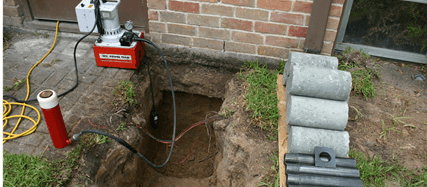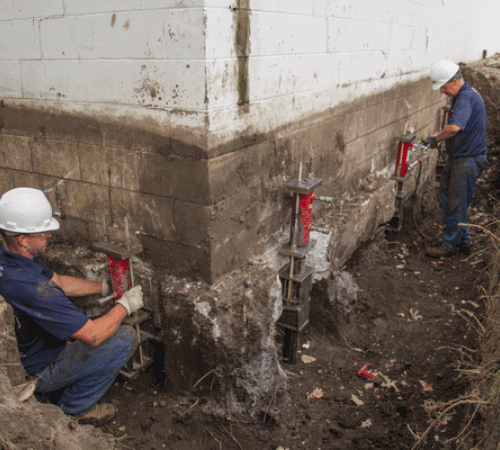Foundation Repair Oklahoma City OK: Tips for Locating the Right Professionals
Foundation Repair Oklahoma City OK: Tips for Locating the Right Professionals
Blog Article
Checking Out Different Approaches of Foundation Repair Work for Numerous Soil Kinds
Structure repair work is a vital facet of keeping structural integrity, especially when thinking about the diverse difficulties posed by different dirt kinds. The intricacy of dirt behavior under varying conditions requires a tailored strategy to repair, making sure optimum remedies such as helical piers for unstable soils or chemical cements for natural layers.
Comprehending Dirt Kinds
Dirt kinds play a crucial function in the security and long life of building structures, making it vital for home owners and building professionals to comprehend their characteristics and habits. The interaction between dirt and structure can determine the structural honesty of a structure. There are several soil kinds, each with distinctive physical properties that affect just how foundations are made and maintained.
Granular dirts, such as sand and crushed rock, supply excellent water drainage and are frequently taken into consideration stable. They have high load-bearing abilities, which can sustain heavier frameworks. However, these dirts can change otherwise compacted effectively, bring about potential settlement concerns. In contrast, natural dirts like silts and clays exhibit different behaviors. These dirts have a tendency to preserve dampness, and their load-bearing capability can vary substantially with adjustments in dampness material.
Rocky soils, understood for their stamina and security, offer outstanding support for structures but may need specific devices for excavation. Conversely, fertile soils, which are a well balanced combination of silt, sand, and clay, commonly offer desirable problems for structure assistance because of their modest drain homes.

Understanding these soil kinds is vital for choosing appropriate structure repair service approaches, guaranteeing the sturdiness and safety of structures in time.
Challenges With Extensive Clay
Among the different soil kinds, large clay presents special obstacles for foundation stability as a result of its tendency to undertake substantial volume adjustments with wetness variant. This kind of soil swells when wet and agreements when dry, which can put in significant stress on frameworks. These changes can result in foundation breaking, heaving, and negotiation concerns, positioning substantial threats to the architectural stability of buildings.
The challenges with expansive clay are exacerbated by its plasticity index, which determines the dirt's capacity to alter shape and volume. A high plasticity index suggests higher possibility for activity, increasing the possibility of damage to structures. This is particularly troublesome in areas experiencing frequent or severe weather modifications, where cycles of damp and completely dry problems are common.
Furthermore, the depth of large clay layers can differ, making complex the assessment and preparation of appropriate structure repair techniques. These intricacies require an extensive geotechnical analysis to make sure effective foundation repair service strategies are applied, highlighting the importance of addressing expansive clay challenges with experience and care.
Solutions for Sandy Soils
Sandy soils, defined by their large particle size and reduced communication, present distinct challenges for foundation stability due to their propensity for changing and disintegration. By anchoring the foundation to deeper, more stable soil layers, these systems can give the essential support to neutralize the shifting nature of sandy soils.
Another suggested approach is the application of dirt stabilization approaches. Chemical grouting, as an example, involves infusing a supporting representative into the dirt, which boosts cohesion and decreases permeability. This process assists to solidify the sandy substrate, thereby minimizing the risk of erosion and activity.
Furthermore, setting up proper water drainage systems is critical in sandy dirt conditions. Guaranteeing adequate water drainage can stop water accumulation around the structure, which typically intensifies disintegration and soil variation. Strategies such as French drains or surface area grading can be employed to route water away from the structure boundary.
Attending To Settling in Loamy Soils
Fertile soils, understood for their balanced mix of clay, silt, and sand, supply an abundant base for numerous frameworks but can often lead anchor to structure settling due to their unique structure. This balanced appearance gives excellent drain and nutrient retention, making it ideal for agriculture and landscape design. However, this very same characteristic can end up being bothersome for foundations, as changes in dampness content can trigger the dirt to expand or agreement, resulting in resolving.
Precise dirt testing is crucial to determine the specific composition and moisture content of the loam. Once information is collected, carrying out appropriate water drainage options is crucial to maintain consistent wetness levels, therefore decreasing the danger of dirt contraction or growth.

Ingenious Repair Service Methods
In the realm of structure repair service, innovative techniques are continuously being created to deal with the complex tests postured by different soil problems. As soil types differ dramatically in their structural residential or commercial properties, traditional methods might not always are adequate. The advent of brand-new innovations in foundation fixing supplies extra tailored options, ensuring security and long life.
One notable innovation is the use of helical piers, which are specifically effective in unsteady or expansive dirts (foundation repair Oklahoma). These piers are screwed right into the ground till they reach a steady layer of soil, using strong assistance for the structure above. This method lessens disturbance and is versatile to various soil types, making it a flexible option
An additional cutting-edge technique is the application of polyurethane foam injection. This method includes infusing high-density polyurethane foam under the structure to fill up gaps and support the structure. It is a much less invasive option to traditional foundation, using fast setup with marginal disruption to the surrounding area.
Furthermore, soil stabilization methods, such as making use of chemical grouts, have gained traction. These compounds enhance dirt strength and reduce permeability, preventing future shifting. Collectively, these ingenious repair techniques supply reliable remedies for the diverse obstacles postured by differing soil problems.
Verdict

Foundation repair is an important aspect of keeping structural honesty, particularly when considering the varied challenges presented by various soil kinds (foundation repair okc). The complexity of soil actions under varying problems demands a tailored technique to fix, guaranteeing click this optimum solutions such as helical piers for unstable soils or chemical grouts for natural layers. By anchoring the foundation to much deeper, extra stable dirt layers, these systems can give the needed assistance to counteract the moving nature of sandy dirts
Structure repair calls for mindful consideration of soil kinds to guarantee security and long life. Chemical grouts enhance soil strength and lower leaks in the structure in cohesive dirts.
Report this page